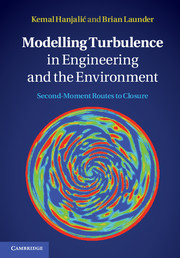Book contents
- Frontmatter
- Contents
- Preface
- Nomenclature
- 1 Introduction
- 2 The exact equations
- 3 Characterization of stress and flux dynamics: elements required for modelling
- 4 Approaches to closure
- 5 Modelling the scale-determining equations
- Chapter 6 Modelling in the immediate wall vicinity and at low Ret
- 7 Simplified schemes
- 8 Wall functions
- References
- Index
8 - Wall functions
Published online by Cambridge University Press: 05 November 2012
- Frontmatter
- Contents
- Preface
- Nomenclature
- 1 Introduction
- 2 The exact equations
- 3 Characterization of stress and flux dynamics: elements required for modelling
- 4 Approaches to closure
- 5 Modelling the scale-determining equations
- Chapter 6 Modelling in the immediate wall vicinity and at low Ret
- 7 Simplified schemes
- 8 Wall functions
- References
- Index
Summary
Early proposals
The label wall functions was first applied by Patankar and Spalding (1967) as the collective name for the set of algebraic relations linking the values of the effective wall-normal gradients of dependent variables between the wall and the wall-adjacent node (in a numerical solver) to the shear stress, heat or mass flux at the wall.
The underlying purpose of wall functions, as originally proposed, was to allow computations to escape the need to model the very complex flow dynamics associated with the low-Re region that formed the subject of Chapter 6. It may seem absurd that in the region which, from a physical point of view, contains the most complex viscous and turbulent interactions, one resorts to algebraic rather than differential relations to resolve the flow. We note, however, that in Chapter 7 the power of using very simple eddy-viscosity models of turbulence to handle the sublayer has been demonstrated. Wall functions may just be seen as an extrapolation of that simplification strategy; that is, an even cheaper approach to capturing the essentials of the viscosity-affected layer, by exploiting the fact that gradients of dependent variables normal to the wall are dominant and that transport effects are relatively uninfluential. The present chapter first summarizes conventional wall functions and then introduces four more powerful approaches that the authors and their colleagues have developed more recently.
- Type
- Chapter
- Information
- Modelling Turbulence in Engineering and the EnvironmentSecond-Moment Routes to Closure, pp. 313 - 347Publisher: Cambridge University PressPrint publication year: 2011

